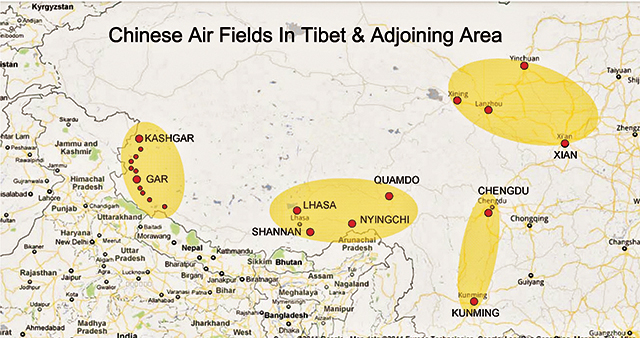Amid the ongoing conflict with China in Eastern Ladakh, Indian agencies are closely monitoring seven Chinese military airbases which have shown increased activity in the last few months.
According to top government sources, the Chinese People’s Liberation Army Air Force (PLAAF) has upgraded a number of these bases in recent times, including the construction of hardened shelters, the extension of runway lengths and deployment of additional manpower.
Sources said these military airbases under Indian watch include three opposite Eastern Ladakh — Kashgar, Hotan and Ngari Gunsa. The other bases include Shigatse, Lhasa Gongkar, Nyingchi and Chamdo Pangta, the sources added.
ALSO READ China downgrades its Chengdu J-20 ‘stealth’ fighter to 4th Generation
“Satellites and other forms of surveillance are being used to keep an eye on the seven Chinese military bases which are situated in Xinjiang and Tibet Autonomous Military Region,” government sources told India Today.


Kashgar Airbase
The Kashgar airbase, approximately 475km from Eastern Ladakh, is the farthest from Indian borders. The recent H-6 bomber deployment is seen as a direct strategic manoeuvre against India.
The dual-use airbase with 3,200m runway has seen apron expansions, new large hangars possibly for H-6 bombers and airborne early warning (AEW) aircraft and 12x hardened aircraft shelters for fighters.
Hotan Airbase
Though the Hotan airbase is a dual-use airport, recent developments indicate it has been converted to military use only.
The airbase has seen new AEW aircraft deployment along with J-8 and J-11 aircraft. New UAV hangars with CH-4 UAVs have been observed after the Doklam standoff.
Large construction has been seen at this airbase for troops and improvement in the ammunition point located there. Recent reports suggest that PLAAF J-20 stealth aircraft were deployed here, although just for two days.
Ngari Gunsa Airbase
The airbase barely 125km from Indian borders has seen small detachments of fighters and helicopters. The airbase has been used for various aircraft trials since it has one of the longest runways of almost 4.5km.
Recently, during a medical exercise, a dummy patient was carried from Ngari town in a helicopter to this airport and further sent to Qionglai in a Y-9 air ambulance of the PLAAF.
Shigatse Airbase
This dual-use airport was converted to an airbase with a stoppage of civil flights after the Doklam standoff.
This airport has seen a new deployment of UAVs with a brand new airstrip for them. New movable hangars have been observed at the eastern end of the airbase.
New aprons for helicopters and a new hangar for possible AEW aircraft are also observed.
Lhasa Gongkar Airbase
The airport serving the capital city of Lhasa now also serves the Shigatse and Tsetang areas of Tibet.
The airport has a new terminal building under construction along with a cargo complex. A third airstrip is planned for further expansion of the airport.
New UAV hangar and apron for the possible deployment of fighters are the new constructions observed here.
Nyingchi Airbase
The airport, only 15km from the Indian border, is the closest airport to India. It is a dual-use airport serving the military town of Nyingchi which accommodates PLA 52 and 53 Mountain Brigades.
The airport has seen a new terminal building and apron expansion. The airport has also constructed accommodations for troops and can serve as an airport for quick deployment or switching of forces.
Chamdo Pangta Airbase
The dual-use airbase has the longest airstrip of 5.5km and is located 165km from the Indian border. The airbase has seen the expansion of runway a decade ago and now observed new additional airstrip.
Although the airbase does not have support facilities required for an airbase, the stealth J-20 was seen deployed here. Probably, it was a trial for high-altitude use of the aircraft.
Sources said of the seven Chinese airbases, six can house fighter aircraft and strategic bomber aircraft built indigenously by the Chinese. The IAF has already deployed its assets along the borders with both China and Pakistan.
The forward airbases of the Indian defence force have been equipped to take care of situations along the western and northern fronts and have seen extensive flying operations in the recent past.














[…] ALSO READ India closely monitoring seven Chinese military airbases […]
I believe Kashgar is closer to Kyrgystan. The map needs to be corrected.